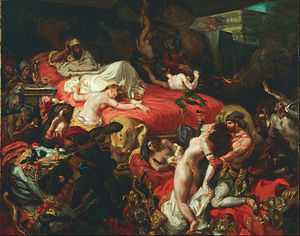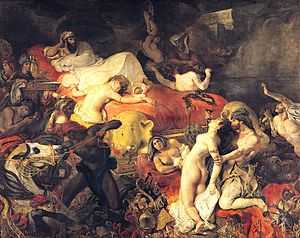The Death of Sardanapalus
| French: La Mort de Sardanapale | |
|---|---|
 | |
| Artist | Eugène Delacroix |
| Year | 1827 and 1844 |
| Type | Oil on canvas |
| Dimensions | 82 cm × 73 cm (32 in × 29 in) |
| Location | Louvre and Philadelphia Museum of Art., Paris and Philadelphia |
The Death of Sardanapalus (La Mort de Sardanapale) are two paintings oil painting on canvas, dated 1827 by Eugène Delacroix. Its dimensions are 392 × 496 cm or 145 × 195 inches. It currently hangs in the Musée du Louvre, Paris.[1] A smaller replica was painted by Delacroix in 1844, that is now in the Philadelphia Museum of Art.[2] The painting in the Philadelphia Museum of Art is 73.71 × 82.47 cm.
Theme

The painting's most dominant feature is a large divan, with its golden elephants, on which a nude prostrates herself and beseeches the apathetic Sardanapalus for mercy. Sardanapalus (Detail) had ordered his possessions destroyed and concubines murdered before immolating himself, once he learned that he was faced with military defeat.
The Death of Sardanapalus is based on the tale of Sardanapalus, the last king of Assyria, from the historical library of Diodorus Siculus, the ancient Greek historian, and is a work of the era of Romanticism. This painting uses rich, vivid and warm colours, and broad brushstrokes. It was inspired by Lord Byron's play Sardanapalus (1821), and in turn inspired a cantata by Hector Berlioz, Sardanapale (1830), and also Franz Liszt's opera, Sardanapale (1845–52, unfinished).
References
External links
| Wikimedia Commons has media related to The Death of Sardanapalus. |
_-_WGA6175.jpg) | |
|
|
- 'The Death of Sardanapalus' - Analysis and Critical Reception
- Eugène Delacroix (1798-1863): Paintings, Drawings, and Prints from North American Collections, a full text exhibition catalog from The Metropolitan Museum of Art, which discusses The Death of Sardanapalus
- The Destroyed Room, a 1978 photograph by Jeff Wall was inspired by this work (TATE Modern).
